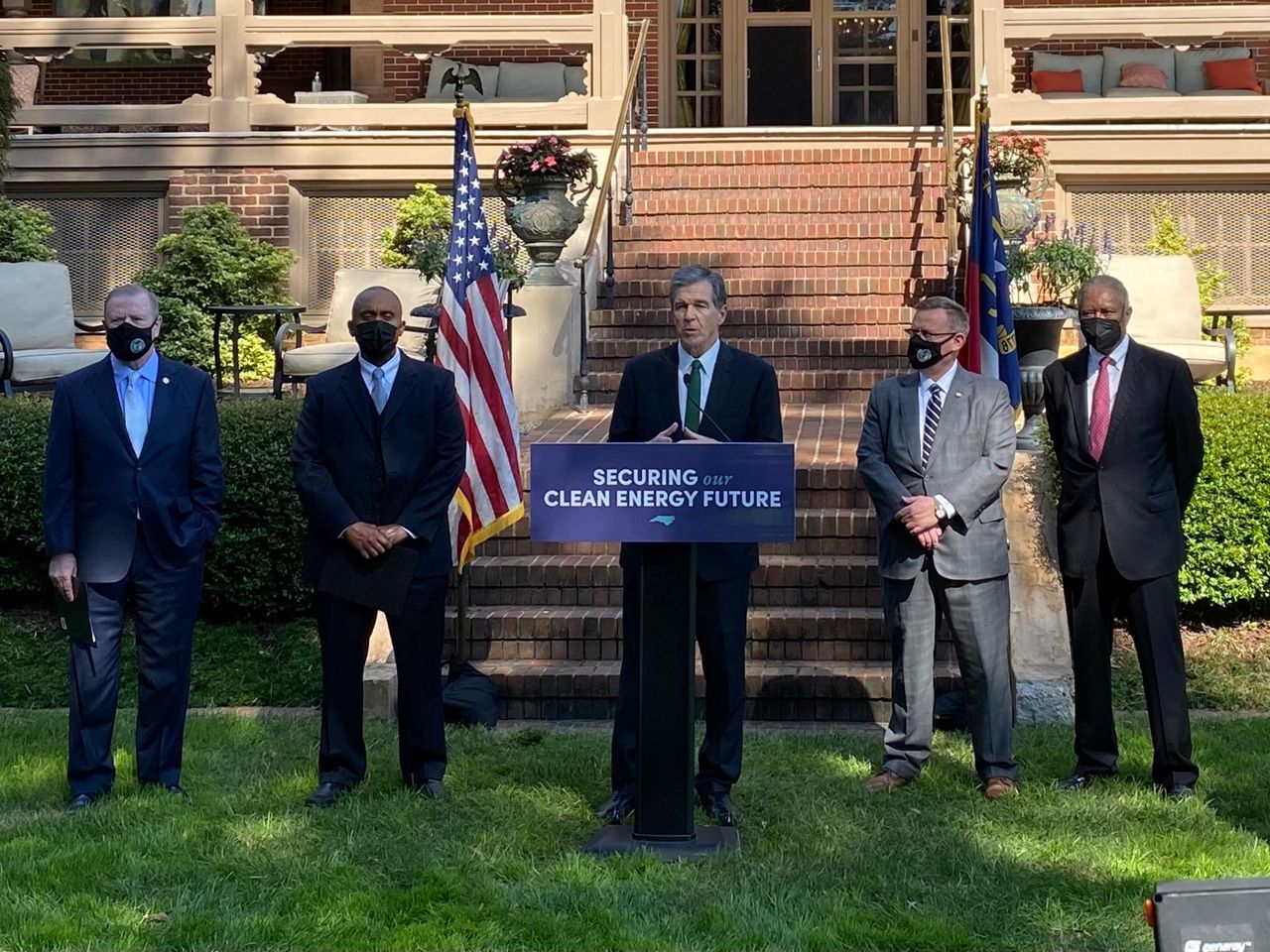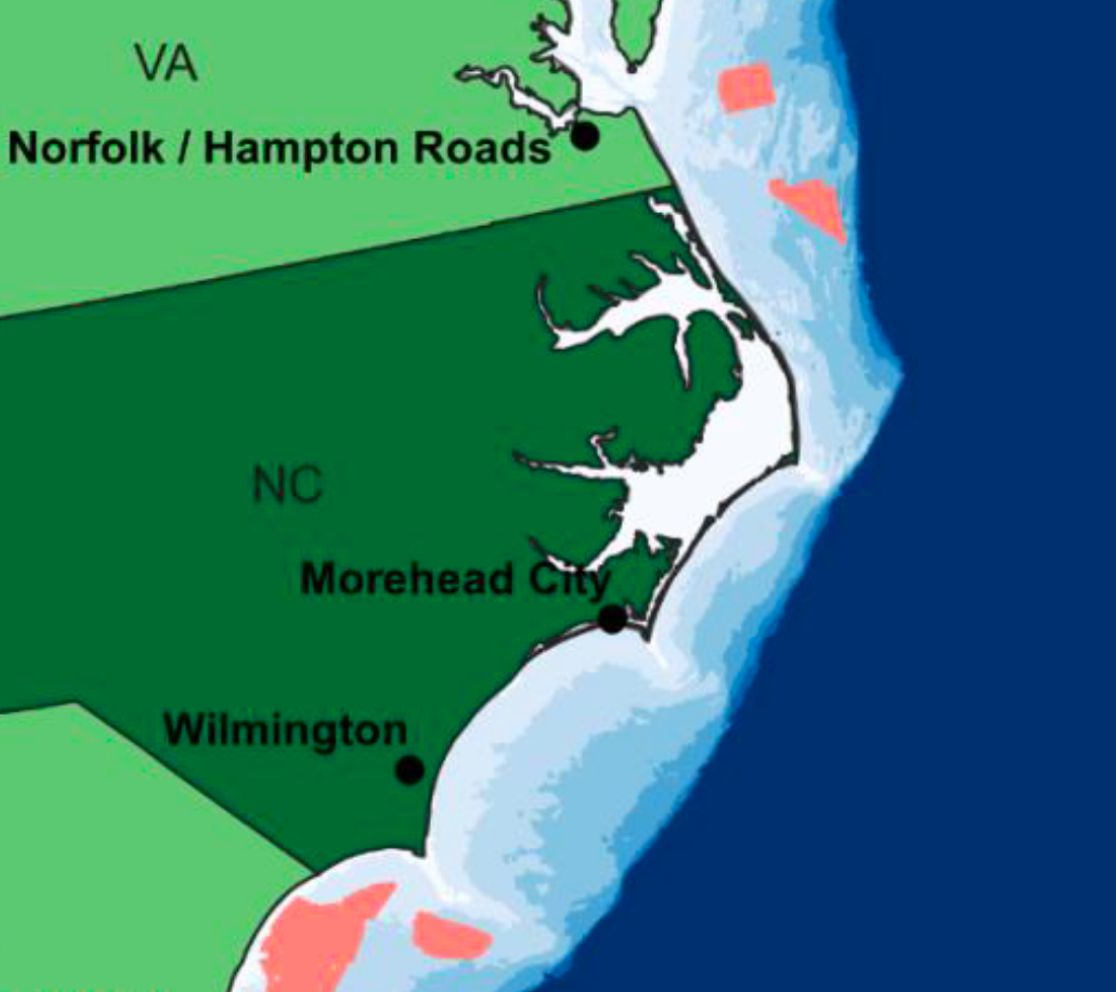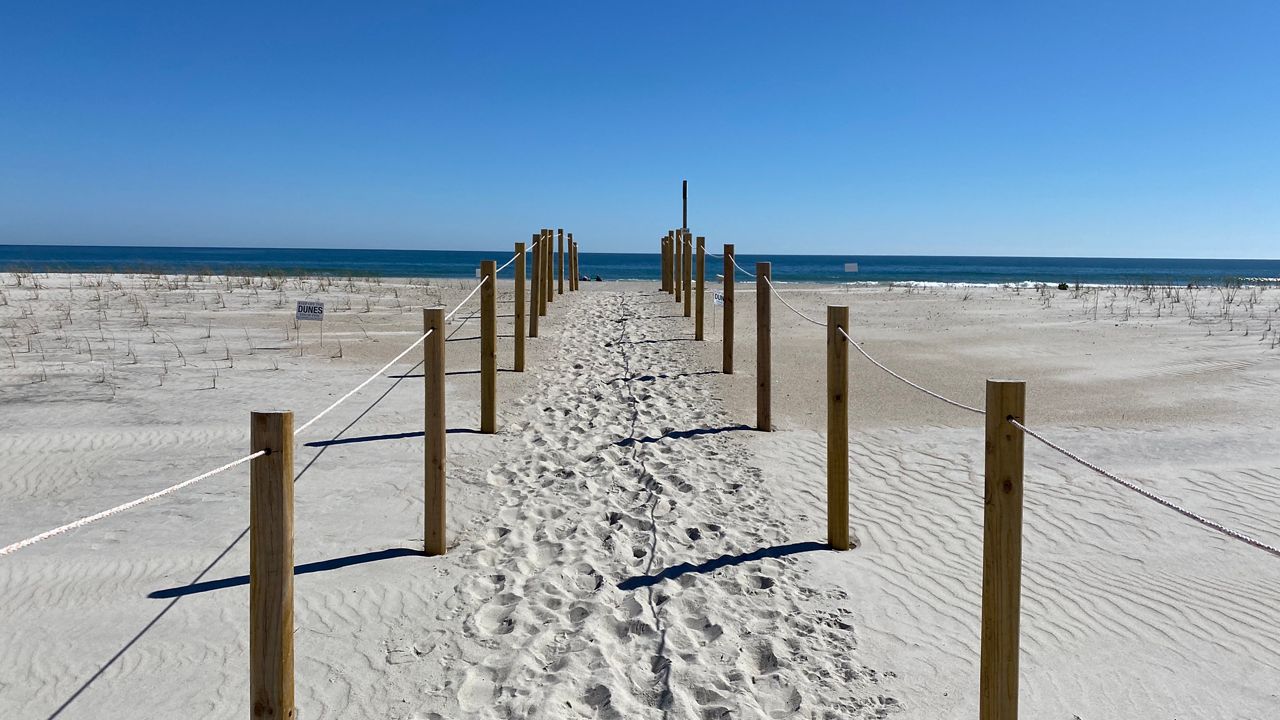This is the second story in a three-part series on offshore wind in North Carolina. Read Part 1: Offshore wind could be big business for North Carolina, here.
The goals are ambitious. Gov. Roy Cooper signed an executive order setting a target of building 2.8 gigawatts of offshore wind energy by the end of this decade and up to 8 gigawatts by 2040. Nationwide, the Biden administration set a goal of installing 30 gigawatts of offshore wind energy by 2030.
Offshore wind farms have been helping power Europe for decades, but there are no big commercial offshore wind farms operating off the United States. Earlier this year, the federal government gave final approval to build the first big offshore wind farm in the U.S. off the coast of Massachusetts.

Off North Carolina’s Outer Banks, there are two massive test turbines installed by a company called Avengrid. Dominion Energy and Avengrid are preparing to build the first offshore wind farm in the mid-Atlantic in the coming years. The lease covers a 200-square-mile area that starts about 27 miles due east of Corolla, North Carolina.
The goal for that wind farm, dubbed the Kitty Hawk project, is to produce 2.5 gigawatts of electricity. That would be enough electricity to power about 700,000 homes. To put that in perspective, the average nuclear plant generates about 1 gigawatt.
As of now, it looks like that power from the Kitty Hawk project will go to Dominion’s customers, mostly in Virginia. But Duke Energy, which provides power for most of North Carolina, could potentially buy some of that electricity.
There are other potential offshore wind sites off Wilmington and further south off the Myrtle Beach area. One of the sites off Wilmington could be leased as soon as May 2022, according to the Southeast Wind Coalition.
Speaking recently at an offshore wind conference in Boston, Interior Secretary Deb Haaland said the Bureau of Offshore Energy Management plans to sell up to seven new offshore wind leases off the coasts of the United States.
“The Interior Department is laying out an ambitious roadmap as we advance the Administration’s plans to confront climate change, create good-paying jobs, and accelerate the nation’s transition to a cleaner energy future,” Haaland said.
“This timetable provides two crucial ingredients for success: increased certainty and transparency. Together, we will meet our clean energy goals while addressing the needs of other ocean users and potentially impacted communities. We have big goals to achieve a clean energy economy,” the secretary said.
Quick Read
If North Carolina is going to hit its goals for offshore wind, the state is going to have to work with private industry to make sure one of those leases is here.
“Offshore wind power will help North Carolina create jobs and generate economic development while helping us transition to a clean energy economy,” the governor said over the summer as he signed an executive order setting the offshore wind goals.
The national push for offshore wind wouldn’t just help the state in its push to clean energy, it could also mean big business for North Carolina.
The state Department of Commerce released a report this year detailing how North Carolina could potentially see billions in investment and jobs to support the offshore wind industry off the East Coast.
“North Carolina’s national leadership in clean energy and manufacturing plus our highly trained workforce create a strong business environment for offshore wind supply chain and manufacturing companies,” Cooper said.
Last year, Cooper and the governors of Virginia and Maryland signed an agreement for the three states to work together to develop the offshore wind industry. The agreement created the Southeast and Mid-Atlantic Regional Transformative Partnership for Offshore Wind Energy Resources, known by the acronym SMART-POWER.
“Offshore wind development combined with our strong solar capacity will bring more high paying, clean energy jobs to North Carolina while we continue to ramp up our fight against climate change,” Cooper said at the time. “This bipartisan agreement with neighboring states allows us to leverage our combined economic power and ideas to achieve cost effective success.”
A clean energy law passed by Virginia’s legislature last year helped pave the way for that state to prepare to start generating power from offshore wind turbines. Now, North Carolina lawmakers have passed a similar law.

Flanked by Republican and Democratic legislative leaders on the south lawn of the Governor’s Mansion last month, Cooper signed North Carolina’s new clean energy bill, HB 951, into law.
The new law took years of pressure from advocates. Republican leaders in the General Assembly negotiated for months with the governor and Democratic leadership.
The law sets ambitious targets to cut carbon emissions from energy generation 70% by the end of this decade and reach carbon neutrality by 2050. Those goals are based on 2005 greenhouse gas emissions levels.
The bipartisan bill gives the state Utilities Commission the power to work with Duke Energy to shutter dirty coal-fired power plants and replace them with renewables like solar and wind.
"For the first time ever, the Utilities Commission has the authority and the duty to cut carbon emissions," Cooper said.
Based on 2019 estimates, solar power accounted for 6% of energy generation in North Carolina, about 4.7 gigawatts, according to the U.S. Energy Information Administration. Nuclear power generated about 32% of electricity used in the state.
The state will need to add a lot more renewable energy generation to hit the goal of carbon neutrality by 2050. That’s where offshore wind can play a big role.
“When you’re looking at a 70% reduction in greenhouse gasses, you need offshore wind to keep the system reliable, to keep energy generation moving onto the grid when consumers are using it,” said Katharine Kollins, president of the Southeast Wind Coalition.
North Carolina’s new clean energy law says dirty coal-fired power plants have to be replaced by “least cost” options. Offshore wind is still very expensive. But, Kollins said, those costs are going to come down as more of the manufacturing is moved to the East Coast and companies don’t have to ship massive turbine parts from Europe.
“In the next decade, the cost of offshore wind is expected to drop dramatically,” she said. “We’re really going to be in a place by 2030 where offshore wind makes a lot of sense for North Carolina.”
“What we’re looking for is, when does wind energy become ‘least cost’ in order to reach these targets?” Kollins said. “All of this is going to be driven in some way, shape or form by Duke Energy, because Duke Energy will be the end purchaser, consumer of that electricity.”
Asked about offshore wind, Duke Energy sent Spectrum News 1 a short statement: “Duke Energy is committed to achieving our 2050 net-zero carbon emission goal, and transitioning our infrastructure towards cleaner, reliable energy resources that are affordable for our customers and communities.”
“As we evaluate the potential for offshore wind and other next generation clean energy technologies to meet our carbon reduction targets, including the requirements established under HB 951, we will engage members of the communities we serve and will listen and fully analyze stakeholder feedback to ensure that Duke Energy’s clean energy transition in the Carolinas is done in a manner that meets our customers, communities and stakeholders expectations,” Duke Energy spokeswoman Jennifer Garber said in an email.

Opinions along North Carolina’s long Atlantic coast are mixed. Offshore wind is a major economic opportunity for eastern North Carolina.
The Kitty Hawk project, the only leased project in the works so far off the North Carolina coast, would start 27 miles east of the Currituck County town of Corolla.
“From an investment standpoint, looking from a jobs standpoint, internships, there’s so many positive things with offshore wind,” said Larry Lombardi, economic development director for Currituck County. “We’re talking about good paying jobs.”
Wind has always been a part of living on the Outer Banks, he said. And he’s all for building an offshore wind farm off the coast there.
“Wind? We’ve had it forever,” he said. “It’s another form of energy that will make us energy independent.”
Currituck County is North Carolina’s most northeastern county, bordering Virginia. Much of the county is less than an hour’s drive from the ports in Portsmouth and Norfolk, Virginia, where Dominion and Avengrid are basing operations for the Kitty Hawk wind farm.
Just based on the sheer size of the offshore wind project and all the workers and suppliers needed to build something that big, Currituck stands to benefit.
“A lot of subcontracting would be close to where the turbines are,” Lombardi said. “It would more than double what we have in jobs.”
Plus, Lombardi said, adding all those turbines out in the ocean will be really good for fishing. The feet of the turbines will essentially create a big artificial reef and attract more fish to an area already beloved by anglers.
With the planned Kitty Hawk wind farm so far out to sea, there’s no real concern on this stretch of the Outer Banks that people could see the turbines from shore.
But on the southern end of North Carolina’s coast, some residents along Brunswick County beaches oppose any offshore wind there.
Federal officials identified two areas off Wilmington and Brunswick County as possible offshore wind areas, but they’re not as far from the coast as the Kitty Hawk project.
In August, the Brunswick County Board of Commissioners unanimously passed a resolution opposed to offshore wind farms within sight of the beaches. They are concerned about the Wilmington West site. It's the Wilmington East site, which is further out, that the Bureau of Ocean Energy Management plans to lease for an offshore wind farm next year.
“The natural coastal beauty of our viewshed is an essential driver of our economy,” the resolution states. “Wind turbines located within the viewshed of Brunswick County beaches would damage tourism and the economy of the county by transforming open ocean views to views of massive industrial machinery.”
The county said that if federal officials lease the site as planned off Brunswick County, turbines could be as close as 10 miles to the shore. The county said the Bureau of Ocean Energy Management has set a limit of at least 24 miles offshore for most of the wind projects already in the works.
Even with major pushes from the Biden administration and the governor for offshore wind, this does not appear to be something federal regulators are going to rush through. They’ve already been working on it for more than a decade.
But with climate change already impacting coastal areas and ambitious goals for cutting carbon emissions, offshore wind will likely be a part of daily life on the coast in the years to come.



